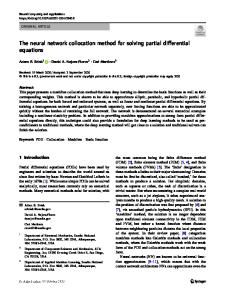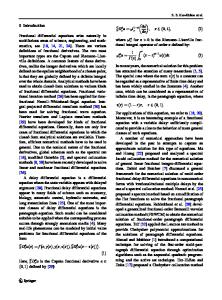Jacobi spectral collocation method for solving fractional pantograph delay differential equations
- PDF / 1,413,478 Bytes
- 10 Pages / 595.276 x 790.866 pts Page_size
- 17 Downloads / 344 Views
ORIGINAL ARTICLE
Jacobi spectral collocation method for solving fractional pantograph delay differential equations Changqing Yang 1 · Jianhua Hou1 · Xiaoguang Lv1 Received: 8 July 2020 / Accepted: 5 October 2020 © Springer-Verlag London Ltd., part of Springer Nature 2020
Abstract In this study, we mainly discuss the application of the Jacobi collocation method to a class of fractional-order pantograph delay differential equations. We first convert the problem to a nonlinear Volterra integral equation with a weakly singular kernel. Under reasonable assumptions of nonlinearity, the existence and uniqueness of the obtained integral equation are derived. Then, we apply a numerical scheme based on the Jacobi collocation approximation to solve the equivalent integral equation. Furthermore, an error analysis for the numerical scheme is performed. Finally, numerical examples are presented to validate our theoretical analysis. Keywords Fractional pantograph differential equation · Jacobi polynomial · Collocation method · Convergence analysis · Caputo derivative Mathematics Subject Classification 26A33 · 65M70 · 45D05
1 Introduction This study is focused on the numerical solutions to a class of fractional pantograph delay differential equations:
D𝛼 y(t) = f (t, y(t), y(qt)),
t ∈ [0, T],
(1)
with the initial condition of y(0) = y0 , where 0 < 𝛼 < 1 , 0 < q < 1 , and D𝛼 denotes the Caputo fractional derivative operator. Fractional calculus has been used in the modeling of many phenomena in fluid mechanics [10], electromagnetism [5, 16], control [1, 17], etc. [28]. Accordingly, fractionalorder models have garnered significant attention in recent decades [13]. Analytical solutions of fractional pantograph differential equations generally do not exist except for certain * Changqing Yang [email protected] Jianhua Hou [email protected] Xiaoguang Lv [email protected] 1
Department of Science, Jiangsu Ocean University, Lianyungang 222005, Jiangsu, China
special cases. Consequently, the numerical solutions of these equations have received considerable attention. Yang [34] adopted the Legendre polynomials and collocation method for multi-pantograph delay boundary value problems. Wang [31] extended the method in [34] to the nonlinear fractional-order differential equation. In [6, 30, 32], the Chebyshev spectral method, including tau and collocation classes, was developed to resolve integro-differential equations and pantograph-type differential equations. In [18, 22, 27], the wavelet method was used to deal with the problems. Moreover, the wavelet method was utilized in time-varying delay problems in [21, 23]. More recently, fractional-order Lagrange polynomials and scaling functions were applied to solve delay fractional optimal control problems in [24, 26]. Rabiei and Sabermahani [20, 25] applied Boubaker and Fibonacci polynomials as the basic functions for solving such problems. Tang [29] constructed pseudospectral schemes with a tunable basis for fractional delay differential equations and provided rigorous error analy
Data Loading...











